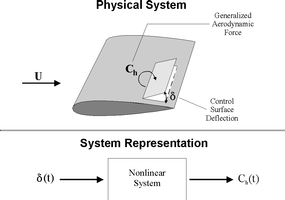The objective of this work was to demonstrate the feasibility of developing a Volterra kernel identification tool for aeroelastic analysis using wind-tunnel and/or flight-test data. The ultimate goal is to provide engineers and scientists with a new nonlinear modeling capability to analyze the aeroservoelastic characteristics of aerospace vehicles and to formulate economical and physics-based reduced-order models suitable for control system design. A low-order version of NEAR's time-domain Volterra kernel identification method has been assembled into a prototype nonlinear identification and prediction software system. This system uses physically realizable inputs, is robust with respect to noise, and minimizes or eliminates the need for analytical assumptions.
 The method has been demonstrated on the aerodynamics of a pitching wing as well as comprehensive tests carried out on noisy synthetic data. The extraction technique has been shown to be accurate, convergent, and robust, and the method can be extended to the extraction of higher-order kernels. The application of the pilot software to data from a pitching wing wind-tunnel model is a successful demonstration of the approach. The pilot system is incomplete in several respects. However, the feasibility of developing a complete Volterra kernel identification system, including capabilities for extracting higher-order approximations and the possibility of coupling this technology with either experimental data or analysis codes has been demonstrated.
The method has been demonstrated on the aerodynamics of a pitching wing as well as comprehensive tests carried out on noisy synthetic data. The extraction technique has been shown to be accurate, convergent, and robust, and the method can be extended to the extraction of higher-order kernels. The application of the pilot software to data from a pitching wing wind-tunnel model is a successful demonstration of the approach. The pilot system is incomplete in several respects. However, the feasibility of developing a complete Volterra kernel identification system, including capabilities for extracting higher-order approximations and the possibility of coupling this technology with either experimental data or analysis codes has been demonstrated.
Commercial Applications: A number of applications for NEAR's Kernel Identification System have been identified. The technology can assist in aeroservoelastic analyses and design activities of aircraft controls and reusable launch vehicles. It may also be useful for the control of space structures. However, the identification and modeling of nonlinear systems considered here is not specifically tied to aerodynamics or structures. Potential applications of the technology include: process control in materials manufacturing, characterization of acoustic liners for noise reduction, nonlinear seakeeping, earthquake engineering, and high frequency electronics. For more information:  Click here.
Click here.
References:
Reisenthel, P. H., " Prediction of Unsteady Aerodynamic Forces Via Nonlinear Kernel Identification." NEAR paper 379. Presented at the 1999 International Forum on Aeroelasticity and Structural Dynamics, Williamsburg, VA, June 1999. 
Reisenthel, P. H., "A Nonlinear Volterra Kernel Identification System for Aeroelastic Applications." NEAR TR 547, Nielsen Engineering & Research, Mountain View, CA, June 1999.
MATHEMATICAL MODELING
Unsteady Aerodynamics Modeling Based on Nonlinear Indicial Response Theory
Nonlinear Volterra Kernel Identification System for Aeroelastic Applications
Nonlinear Time-Domain Characterization of Acoustic Liners From Liner Response Data
Multidimensional Response Surface Technology





